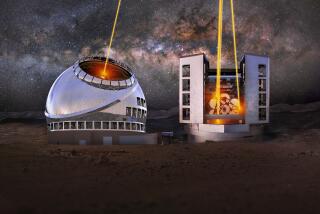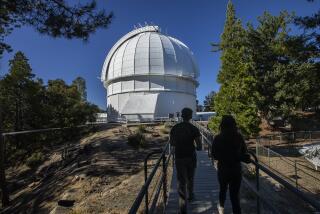Book Review : An Affectionate Memoir of the ‘Big Eye’
- Share via
First Light: The Search for the Edge of the Universe by Richard Preston (Atlantic Monthly Press: $18.95; 263 pages)
My earliest memory of science dates to when I was 3 or 4, and my cousins, a year or two older, talked about the new 200-inch telescope on Palomar Mountain. I was curious about that device.
More than 30 years later I had an opportunity to stand at the top of that telescope, at the lip of the barrel that points to the sky, and to step into a small observing room, the Prime Focus cage, that hangs there. It was one of life’s most sublime experiences.
People who remember the 1930s recall the casting and grinding of the 200-inch mirror for the telescope as one of the great engineering achievements of the decade. They remember the train that carried the mirror from Corning, N.Y., where it was cast, to Pasadena, where it was ground.
Work on the telescope stopped during World War II. But when the war ended, work resumed and the telescope saw its “first light” in 1949. Today it remains the world’s finest telescope, a thrilling combination of precision and beauty, able to see objects billions of light-years away, which also means looking billions of light-years back in time. (The Russians have a 236-inch telescope, but it does not work as well. The 200-inch on Palomar Mountain focuses its images more sharply.)
The Telescope and the Task
Caltech’s Hale Telescope and the astronomers who use it are the subjects of Richard Preston’s engaging book, “First Light,” a title that refers both to the telescope and to its task: seeing far back into time, almost to the beginning of the universe, the Big Bang.
Preston is a very talented young science writer who shows us the astronomers at work on the mountain and leads us through their frontier astronomy. The book resonates with the symbiosis of people and an instrument.
He writes lovingly, almost reverentially, about the telescope, which its users call Big Eye, about the people who built it (many of whom he interviewed), and about how it works. He also writes about how astronomers work and captures the thrill of doing astronomy. Preston never loses his sense of awe at the enterprise.
Spying on the Universe
We join astronomers Maarten Schmidt, Jim Gunn and Don Schneider, spending nights scanning the sky in search of quasars, the mysterious objects at the farthest reaches of the visible universe that Schmidt discovered in the 1960s.
They want to examine very old quasars, whose light has been traveling to Earth for 10 billion years and longer, to see what the universe looked like, way back then, near its creation. They are trying to add to our knowledge of the question, “Where did all this come from?”
Preston describes what’s involved:
“The systems required to operate a modern telescope are similar to the systems used to operate a spy satellite. One needs a mirror. One needs an electronic camera that focuses large amounts of faint light onto a small, hypersensitive silicon sensor chip. One needs a knowledge of computer programs and of robots. The difference is that astronomers point their sensors away from the Earth.”
Besides the Hale Telescope, Palomar is also home to several smaller telescopes, and at one of them, the 18-incher, we meet Gene and Carolyn Shoemaker, who are doing research into solar system astronomy, which Preston describes as “the two-dollar table in the grand casino of the sky.”
With Great Clarity
Just as Schmidt, Gunn and Schneider used the 200-inch telescope to find objects farthest from the Earth, the Shoemakers were using the 18-inch instrument to find objects closest to it. It turns out that there is a good deal still unknown about our own solar system, particularly about asteroids and comets.
Preston writes with great clarity about all of this, skillfully interweaving history, technology, science and personalities. There is an excellent profile of George Ellery Hale, the idiosyncratic astronomer who built the telescopes on Mt. Wilson and dreamed of the 200-inch telescope on Palomar that now bears his name. He died in 1938 and never lived to see it.
Preston’s explanations of the astronomy--both the observations and the theories--are first-rate. He’s always at the right level of abstraction, neither mired in details nor lacking them. He takes care with the facts. For example, he never calls the place Mt. Palomar. It’s correct name is Palomar Mountain.
The result is a very good introduction to astronomy that is also a very good description of how astronomy--and science--are actually done. Preston reminds the reader from time to time how cold it is on top of a mountain all night. He also conveys the fun of it, the sense of the hunt.
“Nature is always doing something under the rug where you can’t see it,” Preston quotes Don Schneider as saying. “Every generation thinks they have uncovered the last rug. They lift up the rug, and they find another rug underneath.”
But most of all, this book is about the Hale Telescope, which Preston calls the dreadnought of its design. (The Keck Telescope now under construction in Hawaii will be effectively 400 inches, but it will contain many mirrors that act as one rather than a single mirror.)
“First Light” is a fitting tribute to a most remarkable device.
More to Read
Sign up for our Book Club newsletter
Get the latest news, events and more from the Los Angeles Times Book Club, and help us get L.A. reading and talking.
You may occasionally receive promotional content from the Los Angeles Times.








